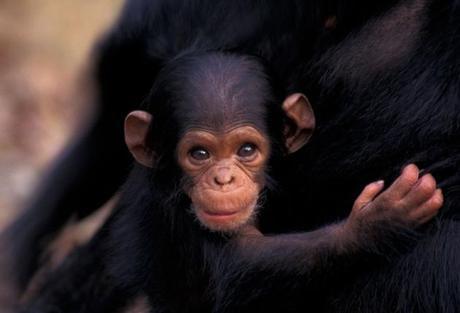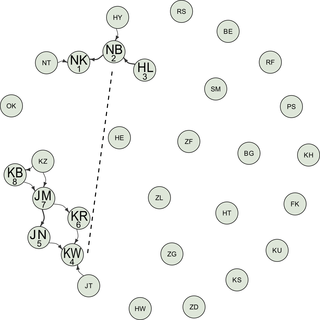
BEHOLD THE FACE OF YOUR DOOM
So now we’re all doomed.
About a month ago I explained why chimps couldn’t take over the world. The crux of the issue was that they were missing a key behaviour which humans have, and without it they weren’t likely to progress far beyond where they are now (although their current state of development is still rather scary). Unfortunately for humanity, new research has been published today that reveals they actually did have this behavior all along1.
So yeah, we’re all doomed now. A hairy, ape-based doom.
The key advantage humans had is that we cheat. We copy each other, learning from one another to figure out how to solve problems. And then once we’ve mastered the other person’s approach there’s a chance we might figure out how to improve it; so when someone cheats off us they’ll learn an even better method (which they may then improve on themselves). In this way human technology effectively keeps ratcheting up, with iteration after iteration of improvement as people copy and improve each other’s methods2.
Chimps kind of learn from one another, but not as well as we do. Say one chimp sees another cracking a nut open with a rock. They won’t directly copy them; like a human would. Instead they’d realize that nuts have food in and rocks can help them get to the food. Then they’d basically re-invent the trick themselves. Although this typically works, it means they aren’t directly copying the other chimp so any improvements the original nut-cracker made will be lost (unless the second chimp also re-invents them)3.
This may seem like a fairly simple difference, but it has some big implications. It’s what allows us to keep improving our technology, year after year, but stops the chimps inventing the iNut 5c. Except does this difference really exist? As I hinted at in my melodramatic opening; new research suggests that chimps are directly learning from each other after all.
Scientists were studying the Sonso chimps in Africa, who typically drink by chewing up a leaf to make sponge; which they then load up with water and suck dry. Then, in November 2011, they visited a new watering hole. Whilst there they learnt two new drinks. The first was using moss as a sponge; the second was re-using a leaf sponge that they’d used. That second one might not sound quite so impressive, but it involves re-using a sponge they used on their last visit to the lake; showing a degree of planning/long term memory. These new behaviours then spread throughout the group over a week or so1.
On the surface this might not seem so interesting. Chimps have been seen developing new behaviours before; and those behaviours have been seen spreading through groups. The key thing here is that they observed the new sponging methods spread throughout the group and they saw that it spread along social networks1. If chimps were just having their attention “drawn” to something which they solved independently, why would it follow this pattern? Do chimps completely ignore other chimps they don’t like? That doesn’t seem to be the case4.
Another key point is that it also spread along social groups based on who was watching who. As such, learning it completely independently can also be ruled out. There definitely was some social component going into it and that’s what excited the researchers most1. But whilst they focused on how great chimps were, I just got worried about how close they were to world domination. Fortunately, they haven’t been seen improving on each others’ techniques yet, so humanity is safe from the chimp menace for now. But now they’re definitely doing social learning, how long will that last?

Chimps watching other chimps at Sonso. Each circle represents a chimp, the arrow represents themobserving another chimp. The number in the circle represents the order they developed moss sponging
This research is also significant for being the first definitive proof of this sort of social learning in the wild. Although new behaviours have been seen spreading through chimp groups before these could have just been chimps coming up with the new thing independently. One chimp learns how to crack a nut, then another and another. No reason they’re influencing each other, right? However, this is the first direct evidence that there is a social component to the learning (which most people already suspected).So that’s big news in it’s own right; which seems to be what most other people are excitedly focusing on. Conclusive proof chimp culture is actually cultural, not just coincidental.
Me though; I’ll be chimp-proofing my house ASAP.
References and notes
- Hobaiter C, Poisot T, Zuberbühler K, Hoppitt W, Gruber T (2014) Social Network Analysis Shows Direct Evidence for Social Transmission of Tool Use in Wild Chimpanzees. PLoS Biol 12(9): e1001960. doi:10.1371/journal.pbio.1001960
- Tennie, C., Call, J., & Tomasello, M. (2009). Ratcheting up the ratchet: on the evolution of cumulative culture. Philosophical Transactions of the Royal Society B: Biological Sciences, 364(1528), 2405-2415.
- Horner, V., & Whiten, A. (2005). Causal knowledge and imitation/emulation switching in chimpanzees (Pan troglodytes) and children (Homo sapiens).Animal cognition, 8(3), 164-181.
- The primary focus of this paper was on social learning, not the specific nature of that learning. I read it and saw that it could contain evidence of chimps learning in a kind of new way; but since it wasn’t the specific focus of the paper it wasn’t rigerously tested. More work is needed in that matter.

